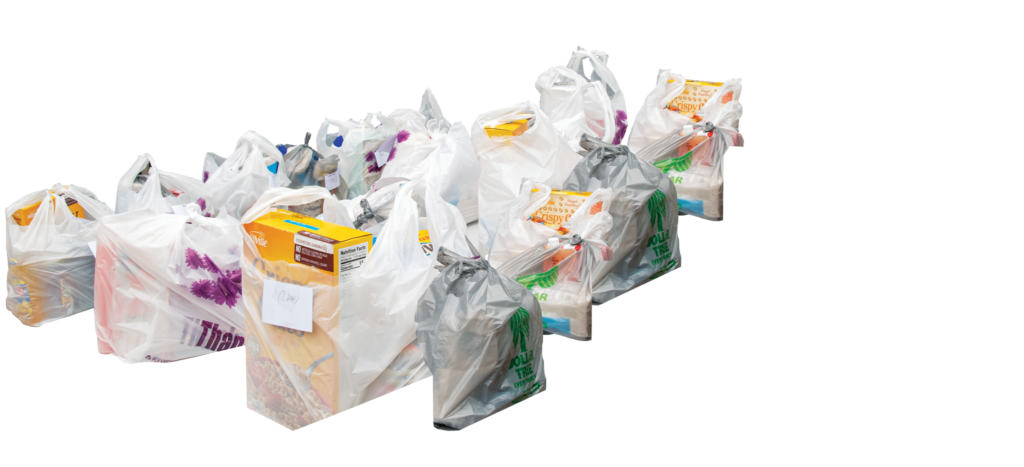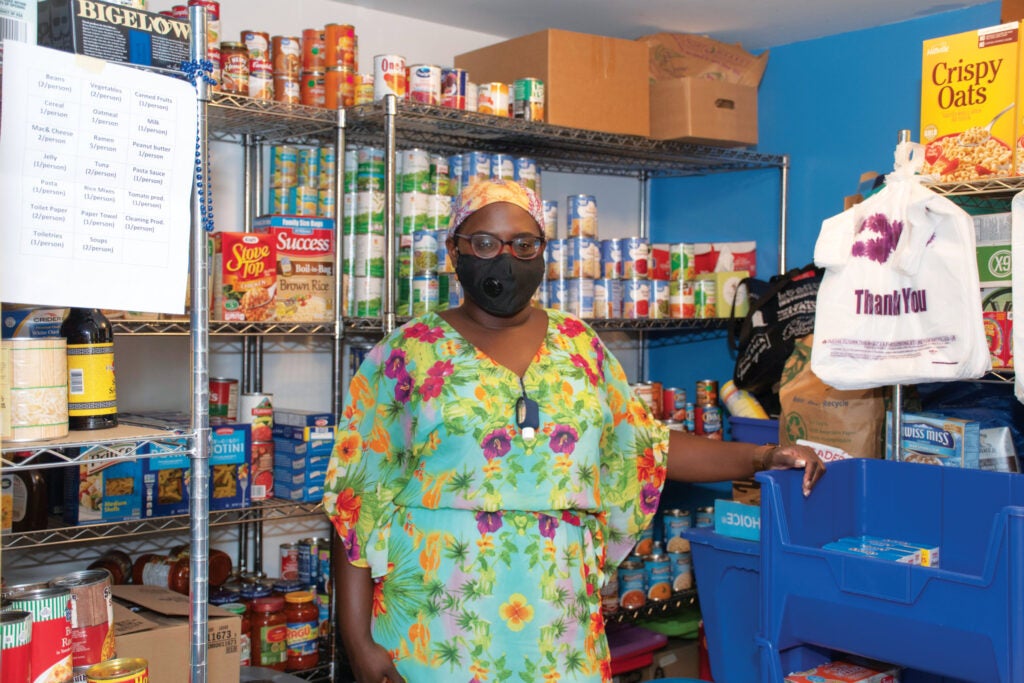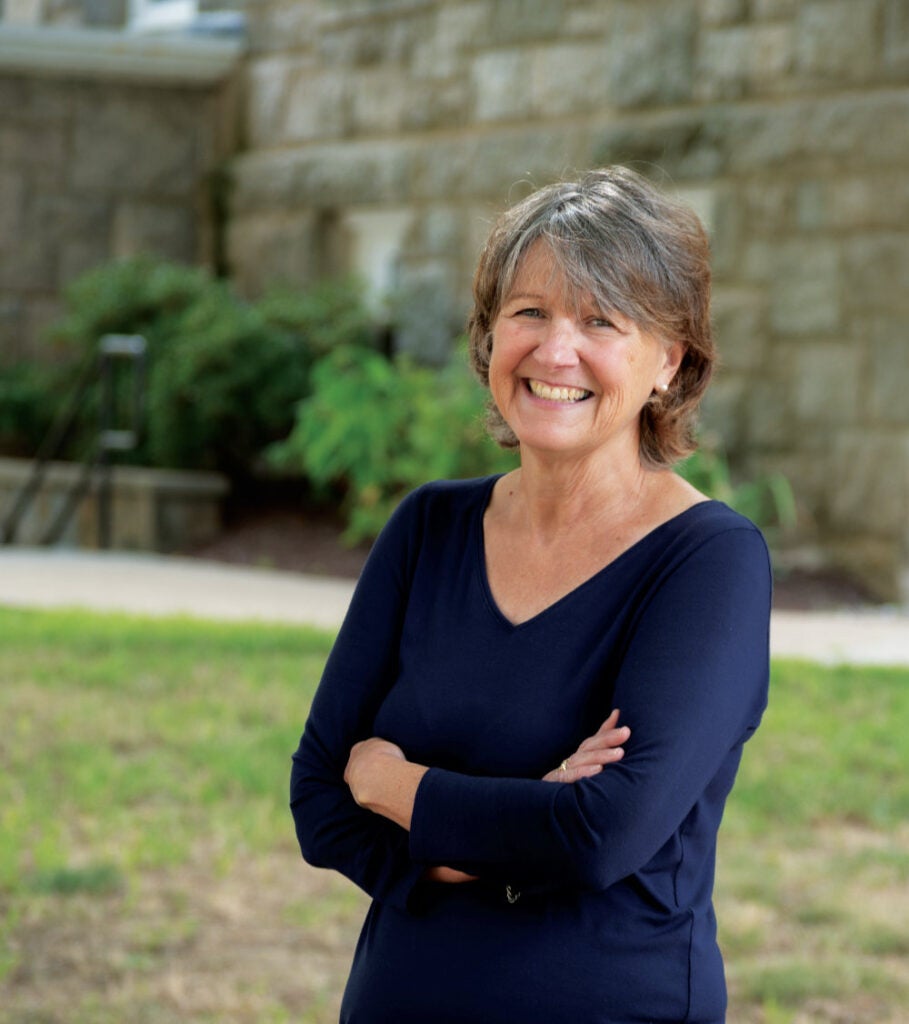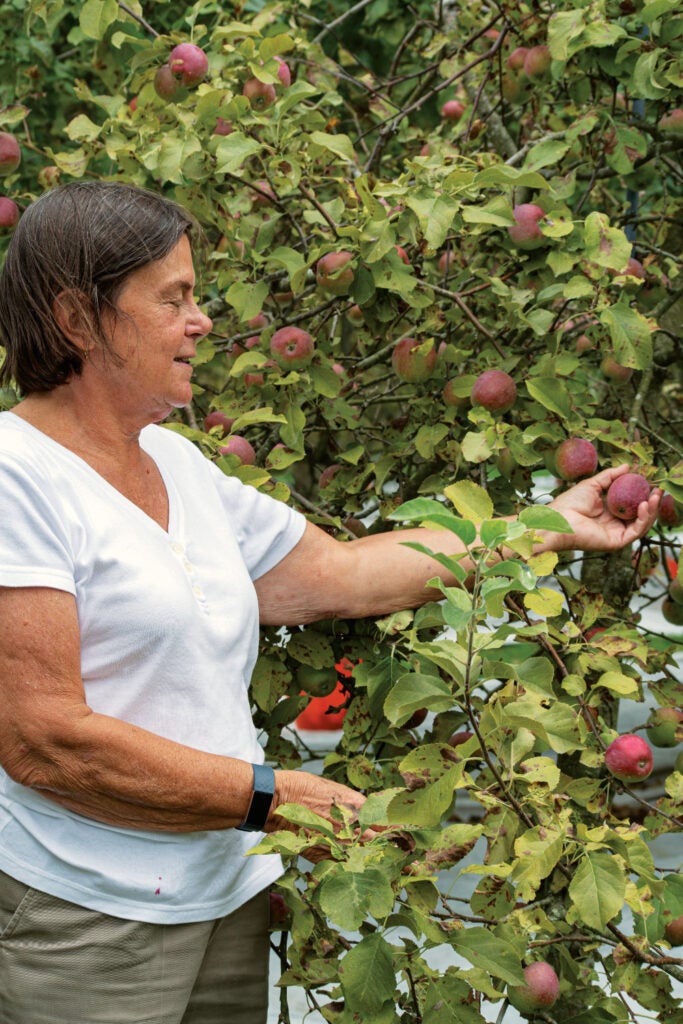Food Insecurity on Campus and Beyond
Apples from URI’s East Farm are sorted and boxed for distribution to URI students and Rhode Island food banks.
Hunger. It’s a widespread problem—even on college campuses. How is URI responding to help get food to those in need? Donating and delivering produce grown in our experimental agricultural fields, running a campus food pantry, advocating to expand the federal school lunch program to public colleges, and more.
By Todd McLeish
An international student living in URI’s Graduate Village Apartments with her three young children was struggling to feed her family while working toward her degree half a world away from her extended family and friends. She was doing the best she could on her limited income, but after paying for her academic expenses, clothing for her growing children, and housing costs, she had little left over for food.
It’s a surprisingly common problem on university campuses nationwide, and URI is not immune. Food insecurity is a growing concern, and the COVID-19 pandemic has made the situation even more challenging for an increasing number of students.
Thankfully, URI has developed a number of resources in recent years to support students in need. It is also growing fresh produce for area food banks and leading efforts to improve access to healthy food for families in need around the state. But much more needs to be done at the state and federal level to address the underlying issues behind these problems to prevent a further escalation of food insecurity on campus and beyond.

Food Insecurity on Campus: The Big Picture
It has only been in the last 10 years that food insecurity has been recognized as a significant problem on college campuses in the United States. According to Kathy Collins, URI’s vice president for student affairs, it’s a subject that simply wasn’t talked about or acknowledged. “It’s an embarrassing thing for colleges to make public,” she says. “But we have to talk about it.”
National surveys have forced the issue into the light.
In 2019, 167,000 students were surveyed by Temple University at 171 two-year colleges and 56 four-year institutions, and 39 percent of respondents indicated they had been food insecure in the previous 30 days, meaning they did not have enough to eat or they were uncertain where their next meal would come from. The rate is lower at four-year schools, where it typically ranges from 8 to 30 percent. A similar survey at URI found about 13 percent of students were food insecure in 2019.
“The expansion and diversity of the people who go to college has really changed the landscape,” says Kathleen Gorman, director of URI’s Feinstein Center for a Hunger Free America, who led the URI survey. “Many more lower-income and moderate-income students with limited support from their families, who before wouldn’t have gone to college, now do. And colleges now have a lot more older students who have families and jobs and are struggling to pay their bills.
“If 13 percent of our students are food insecure—and the true number is probably higher than that—then that means a couple thousand students are hungry,” she adds. “That’s not OK.”
Assisting URI’s Food-Insecure Students
The demographics of those experiencing food insecurity varies widely among URI students, but it includes commuters, in- and out-of-state students, grad students and even some who live on campus. Student-athletes are particularly susceptible to food insecurity, as only 25 percent are on full scholarship, and their required training regimen—coupled with their coursework—leaves little time to earn extra income.
Jacqui Tisdale, Ph.D. ’14, assistant dean for outreach and intervention in the URI Dean of Students Office, said the survey numbers aren’t surprising, since the issues people are faced with across the country—and that are illustrated by increased visits to food banks—also play out on college campuses.

“Today’s students are pretty savvy,” she says. “They eat out of vending machines, they borrow meal swipes from their friends, they order a pizza and make it last for eight meals. Food insecurity has close ties to housing insecurity, and we see a number of students who have to make choices between stable housing, food, and books. Their version of housing insecurity just looks a little different—they’re couch surfing with friends or living in their cars and lack a consistent address.”
Tisdale serves as a case manager on campus, so students who are hungry eventually find their way to her. She guides them to a variety of services that are now available.
“Food insecurity has close ties to housing insecurity, and we see a number of students who have to make choices between stable housing, food, and books.“
—Jacqui Tisdale, Ph.D. ’14, Assistant Dean for Outreach and Intervention
Rhody Outpost, the campus food pantry, was established in 2013 by two students as their final project in Gorman’s class. They had an inkling that food insecurity was a concern for many students on campus and believed that if a food pantry were available, students would use it. They were right. Located in the basement of St. Augustine’s Episcopal Church on Lower College Road and administered by the Dean of Students Office since 2017, it regularly serves the needs of hundreds of students, thanks largely to donations from church members, campus food drives, and fundraising by Greek Life.
In the fall of 2018, a meal-sharing program was launched enabling students on meal plans to donate one meal per semester to students in need. Called Share a Swipe For Hope, the program is modeled after the national Swipe Out Hunger program. Students donate “guest swipes” from their meal plan via a dining hall kiosk, and those seeking meals can apply to have a certain number of meals added to their ID card so they can easily access meals with their peers anonymously.
“We run a big campaign every fall and spring to encourage students to share a swipe, and we get a great response,” Tisdale says. “There are usually enough swipes donated to meet the need, in part because that’s not the sole program we offer.”
Students with greater needs than an occasional meal can also apply to the Students First Fund, which provides financial support to students with demonstrated financial need for a variety of emergency uses, including for the purchase of groceries or even an entire dining hall meal plan. “Share a Swipe meals are often used for students who are not in the best financial standing with the University—those that might have an outstanding balance on their university account or who might not be actively enrolled but are still coming to campus regularly for one reason or another,” Tisdale explains. “To access the Students First Fund, students must be enrolled in classes, be in good financial and academic standing, and they must have exhausted all other financial aid options.”
URI Responds to Hunger in Rhode Island

Food insecurity isn’t just a problem on campus, of course. About 11 percent of Rhode Island households worry about where their next meal will come from, according to a 2019 report, but that number doubled this year due to the pandemic. National figures are similar.
“Unemployment skyrocketed when the pandemic hit, and the last thing you spend your money on is food,” Gorman says. “There are certain things that are less flexible—you pay your rent so you don’t get evicted, you pay for transportation to get to your job. But people scrimp on food. And food prices have gone way, way up.”
It’s an even greater problem in some segments of society. Data from the U.S. Department of Agriculture shows that one out of every five Black households, one out of seven Hispanic households, and one out of three single-mother households regularly experience food insecurity.
“If you’re worried all the time about whether you can get food and how to pay for it, it’s not just about the food. It’s the psychological stress and constant worry.”
–Kathleen Gorman, Director, URI Feinstein Center for a Hunger Free America
“It’s a huge issue. And if you’re worried all the time about whether you can get food and how to pay for it, it’s not just about the food. It’s the psychological stress and constant worry,” says Gorman. “You can make an argument that it’s an economic problem and a health problem and a physical nutrition problem, as well. For kids in school who can’t get enough to eat, it affects their academics, their behavior, how they feel about themselves. It spills over into all kinds of things.”
A number of efforts are underway around the URI community to respond to this growing problem. Gorman has had a contract for 19 years with the state of Rhode Island to manage its SNAP Outreach Project, which involves helping potentially eligible individuals and families gain access to Supplemental Nutrition Assistance Program (SNAP, formerly called food stamps). She has had a team of staff and students visit community centers and other agencies to provide information, conduct screenings, and help people fill out the complicated paperwork and compile the necessary documents to apply for SNAP benefits. They also help recipients complete interim reports and recertify that they still qualify.
This year, the state has taken over the program, but Gorman and Tisdale have applied to make URI a community partner in the program to help URI students—as well as students at Rhode Island College and the Community College of Rhode Island—access SNAP benefits.
In addition to Gorman’s work, URI Cooperative Extension coordinates a SNAP Education program led by Sarah Amin, assistant professor of nutrition. She oversees a team of 20 staff members who teach nutrition education to low-income families in urban communities in Rhode Island. The federally funded program encourages people to choose nutritious food through hands-on programming.
“One of the critical aspects of our programs is food resource management skills—how to stretch your food dollar and use it wisely,” Amin says. “We empower participants with cooking skills and food preparation skills, in addition to nutrition information, to make the best food decisions. We teach them how to make a grocery list, for instance, and how to understand unit prices when shopping.”
URI Master Gardeners grow food on the URI campus and in community gardens, which they harvest and distribute to Rhode Island food banks and other agencies.
Sharing the Harvest
The University also grows a great deal of fresh produce in its agricultural research fields, most of which is donated to local food banks like the Jonnycake Center in Peace Dale, where Kate Brewster ’95 serves as executive director. Tens of thousands of pounds of squash, corn, melons, peppers, tomatoes, and other crops are harvested on campus each year to feed those in need.
“The Agricultural Experiment Station has been around since 1892, and there’s always going to be extra food when you’re experimenting with crops,” says Tim Sherman ’10, who manages the operations at the Gardner Crops Research Center, also known as the Agronomy Farm. “We’re doing fertilizer trials, we’ve got a study on sweet corn, we’ve got a pepper trial. And every year we have crops to harvest from what the students in the vegetable production class have planted.”
Although some of the produce could be sold, the University doesn’t want to compete with local farmers. “The Experiment Station and Cooperative Extension are here to help local farmers and build agriculture in the state,” Sherman says. “That’s why we do variety trials in the first place—to see what vegetable varieties grow best in our environment to help our farmers. We don’t want to be competing with them for sales.”
In addition to what’s grown on campus, URI Master Gardeners grow tons of fresh produce each year—15 tons last year alone—at more than a dozen community gardens around the state for donation to food pantries and other hunger-relief agencies. According to Vanessa Venturini ’08, M.E.S.M. ’11, the Master Gardener state coordinator, they tend vegetable gardens at House of Hope in Warwick, for instance, where many individuals formerly experiencing homelessness now live, and partner with SNAP Education staff to offer workshops to teach the residents how to cook the vegetables they grow. Gardeners tending the Produce Donation Garden at Roger Williams Park in Providence and the Grow4Good Garden at Mount Hope Farm in Bristol do similar workshops for clients of local food pantries.
Connecting Growers, Produce, and Those in Need

At the far corner of URI’s East Farm, a mile from the Kingston campus, a dozen Master Gardeners and other volunteers using long-handled poles harvest apples from the University’s research orchard every week from mid-August through October. Some pick by hand, while others load bright orange totes with apples and sort them before placing them onto a truck for delivery to Graduate Village and the Jonnycake Center. By the end of the season they will have harvested more than 15,000 pounds of apples from 159 apple trees of 11 varieties that would otherwise have dropped to the ground to spoil. A dozen nearby peach and pear trees are also harvested.
Master Gardener Susan Axelrod ’89 has coordinated the harvest for the last four years, often bringing in school and scout groups, Grad Village residents, and others to help pick, though the pandemic limited this year’s participation. “Everyone has fun picking in the orchard,” she says.
The logistics of this year’s harvest were managed by Hope’s Harvest RI, a Pawtucket-based nonprofit that has partnered with the Master Gardeners to collect surplus produce from local farms around the state to deliver to hunger relief agencies in a practice called gleaning. Hope’s Harvest gleaned more than 80,000 pounds of produce last year that would have otherwise gone to waste. By training Master Gardeners to lead gleaning trips to area farms, it expects to triple that number this year.
“I can’t live in a place where we’re plowing under food and we have people who don’t have food. It’s a community—we have so much food, we just need to get it to the right people.”
—Sharon Pavignano ’74, Associate Director of Corporate and Foundation Relations for the URI Foundation and Alumni Engagement
“There are a lot of things that farmers can’t control, like the weather and pests, so they often grow more than they need to mitigate risk,” says Eva Agudelo, executive director of Hope’s Harvest. “That’s them being good farmers. But they may not have the labor to harvest crops they know they can’t sell, so Hope’s Harvest provides the labor and infrastructure. We coordinate with volunteers and food pantries for deliveries.”
Master Gardener Sharon Pavignano ’74, associate director of corporate and foundation relations for the URI Foundation and Alumni Engagement, also has her hands full during the harvest season. In addition to her regular job responsibilities, she facilitates the movement of produce around campus and ensures that nothing goes to waste. She makes sure Rhody Outpost is supplied with fresh produce each week, alerts the residents of Grad Village when certain crops will be available, coordinates with Dining Services to transport food around campus, and delivers produce to nutritionist Kelli Kidd, who counsels student-athletes, for distribution to hungry athletes. Pavignano even found funding to build a vegetable garden at Grad Village and recruited Master Gardeners to serve as mentors to the student gardeners.
“I can’t live in a place where we’re plowing under food and we have people who don’t have food,” she says. “The people growing the food probably didn’t know about the food insecurity issue and don’t have time to move melons to where they’re needed. It’s a community—we have so much food, we just need to get it to the right people.”
Pavignano also coordinates the annual Food Summit, hosted by the URI Business Engagement Center, a networking opportunity for those in the food industry to hear from local experts, discuss partnership opportunities, learn about funding sources, and support the development of the local food movement in the state. The theme of the 2021 event in January is food insecurity. It is hosted by the Rhode Island Food Center, which Pavignano had a hand in launching on campus in 2016 as a place where farmers, growers, producers, distributors, servers, retailers, and other food pioneers can easily access URI’s agricultural resources, wider food expertise, researchers, and business support programs.
Students who live at URI’s Graduate Village Apartments help harvest and package apples from East Farm. They take home part of the harvest for their own households; the rest is distributed to food banks.
Address the Root Causes
Despite the wide range of activities and programs the University is engaged in to address food insecurity on campus and in the state, the problem is far from solved. To do so, according to Gorman, requires that the root causes of the issue be addressed: low wages and a poorly funded safety net.
“Living wages—which is a lot more than $15 per hour—would be the goal and would go a long way toward remedying the problem,” Gorman says. “But not all people are working or can work, so we need a safety net, and that’s where SNAP comes in. It has the potential to make a huge difference in the lives of many families, so keeping it strong and well-funded is critical. We can do that, with a little political will.”
Gorman has advocated at the federal level to expand the K–12 free- and reduced-price school meals program to the state’s public colleges, in part because many college students don’t qualify for SNAP benefits, though the effort hasn’t gotten much traction yet due to the cost.
“If families are struggling, we need to help them,” she says. “If students are struggling, we need to help them. It’s complicated, I know, but we should do it anyway.” •
Students First Fund
Established in 2014, the Students First Fund provides emergency support to URI students with demonstrated financial need. While it is often used to provide meals to students experiencing food insecurity, it has also reimbursed travel expenses so students can attend a family funeral, paid for medical expenses not covered by health insurance, and subsidized the cost of books and other academic supplies. During the pandemic when classes shifted online, the fund even paid for cell phone costs to access remote classes, since many students are dependent on their phones for internet access.
The fund is managed by the URI Foundation and administered by the Dean of Students Office. Those interested in contributing to the fund are encouraged to contact Sharon Pavignano at URI Foundation and Alumni Engagement at spavignano@uri.edu.
PHOTOS: NORA LEWIS
